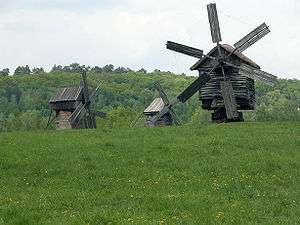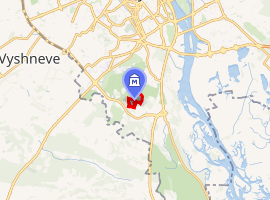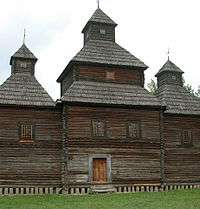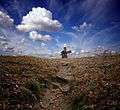Pyrohiv
Pyrohiv (Ukrainian: Пирогі́в), also known as Pirogov (Russian: Пирого́в), originally a village south of Kiev, is a neighborhood in the southern outskirts of the Ukrainian capital city. It is now home to an outdoor Museum of Folk Architecture and Life of Ukraine.
Музей народної архітектури та побуту України | |
 | |

| |
| Established | 1969 |
|---|---|
| Location | Kiev, |
| Type | Open-air museum |
| Collection size | 300 architectural exhibits, 70,000 artifacts |
Although the origin of the toponym is uncertain, pyrohiv is genitive plural form of the Ukrainian word for pie.
Location
Archaeological evidence confirms that the territory of Pyrohiv has been settled at the times of the Bronze Age. Pyrohivka settlement was first mentioned in 1627, as a feudal domain of the Kievan Cave Monastery. The 1720 records mention the village of Pyrozhov. The territory was included within the Kiev administrative boundary in 1957.
Two modern streets now go along the historic road Pyrohiv way (Pyrohivs'kyi Shlyakh): the Stolychne Shose (Capital Motorway) and Novopyrohivska (New Pyrohiv) Street..
Museum

The territory of historic Pyrohiv now serves as the location of a 1.5-square-kilometre (370-acre) outdoor Museum of Folk Architecture and Life of Ukraine. Founded in 1969, the museum contains over 300 pieces of folk architecture brought here from all parts of Ukraine and carefully reassembled. The picturesque hill with several windmills is the museum centrepiece and the entire territory of the museum is divided into sectors, each representing the folk architecture and life of a specific Ukrainian region. The oldest church, situated in Pyrohiv, is Naddnipryanska, it is built in 1742. In the museum you can also find more than 40 000 items of household and traditional culture such as costumes, old textiles, embroidery, carpets, ceramics, metal handicrafts, woodwork and glass-ware as well as musical instruments, paintings and houseware.
Commoner's homes, buildings of small trade, commerce and local administration, and old wooden village churches contain authentic items that represent the everyday lifestyle of Ukrainian villagers and townsfolk. Local volunteers and modern Ukrainian artisans selling their wares dress in old-style clothes and demonstrate the use of authentic everyday items to visitors.
One of the main distinctive features of the museum is its theatrical performances and open-air celebrations dedicated to different folk holidays. Also in Pyrohiv you can often meet workers of the museum and visitors who are dressed in national costumes as well as those who are participating in ancient crafts like weaving, molding and others. In autumn and in summer holidays of folk crafts take place here. Blacksmiths, potters, weavers and other masters show their crafts to public and create works of art in front of your eyes.
Pyrohiv museum has been accorded the status of State Museum of Ukraine and is affiliated with the Institute of Arts, Folklore and Ethnology of the National Academy of Science of Ukraine.
To get to the museum from the underground station Demiivska take the trolley bus №11 or from the underground station Demiivska or Golosiivska the minibus taxi №172 and 156. The museum’s working hours are from 10 a.m. to 5 p.m. There are excursions for tourists in English, Ukrainian, Russian and German.
Recent controversies

In recent years, several of the museum's wooden buildings have been damaged by fires. The most recent fire on September 15, 2006 completely destroyed one house and seriously damaged two others. According to both Institute Director Hanna Skrypnyk and the Ukrainian Ministry of Emergencies, the fire was the result of arson, set to cover up the theft of a valuable collection of eighteenth-century cassoni which were exhibited in the burned building. Skrypnyk noted that in Soviet times the museum had a designated security group and fire house, which were disbanded after the Soviet collapse owing to negligence in financing on the part of the Ukrainian government.
The land usage in the vicinity of the museum has become the centre of scandal as the local authorities approved several commercial construction projects, including a luxurious high-rise entertainment complex and a gasoline filling station. The construction work for the former is now stalled due to the public outrage, but the work on building the filling station near the museum entrance has proceeded.
See also
References
- (in Ukrainian) Museum of Folk Architecture and Life at Wiki WWW-Encyclopedia of Kiev
- (in Ukrainian) Pyrohiv at Wiki WWW-Encyclopedia of Kiev
- Museum of Folk Architecture and Life. Photo gallery
- (in Russian and Ukrainian) Natalya Blyznyuk, The Pyrohiv museum is in danger, Ukrayina i Svit, March 3, 2006, in Russian, in Ukrainian.
- (in Russian) Vladimir Kaminsky, Is the Pyrohiv museum in danger?, Sevodnya, March 3, 2006
- (in Russian) The Pyrohiv museum in Kiev was almost burnt, Gazeta po-kievski, August 16, 2006
- (in Russian and Ukrainian) "The scientists think that the fires in Pyrohiv are used to cover the theft from the museum", September 26, 2006, Korrespondent.net, in Russian, in Ukrainian
- (in Russian) "The damage from Pyrihiv fire is estimated at 4 mln UAH", September 25, 2006, Glavred.info.
- Video from Pyrohiv (4k, UltraHD)
Action Romance movie Bitter Harvest Feature Film about Ukraines Genocide Holodomor 1932/33 by soviet Russian communist dictator Stalin was filmed on location in Pyrohiv Kyiv district Ukraine depicting the authentic Ukrainian land and village timber and thatched roof huts and cabin homes and Orthodox timber constructed churches in the first ever English language feature love war story written by half Ukrainian Richard Bachynsky Hoover from Kingston Ontario Canada raising his son Yevhen (Genya ) Nyanchenko in Kyiv district Bucha Ukraine. See Bitter Harvest film website regarding Pyrohiv museum @ www.bitterharvestfilm.com




